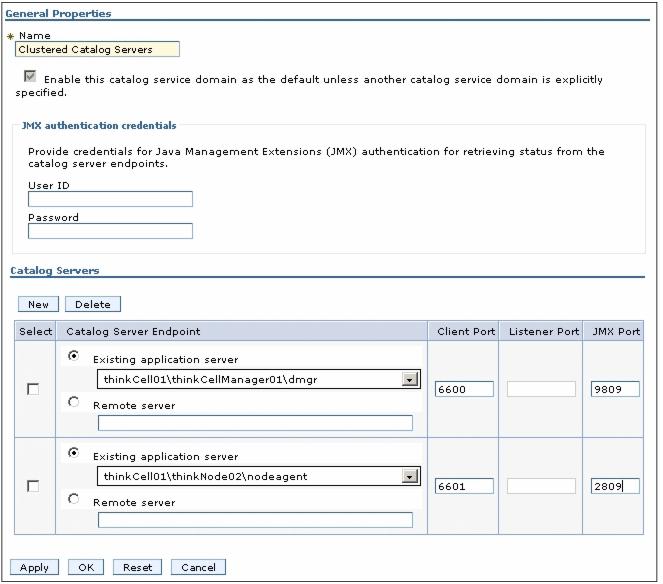Creating a catalog service domain
We will define the catalog service domain as shown below.

The catalog server manages the placement of partitions and to allow clients to connect to the grid.
By default, the WebSphere eXtreme Scale catalog server will run in the deployment manager of the cell. This is a convenient default, but is not resilient if it is the only catalog server. The catalog server can be configured to run in other servers as well, such as the node agent(s) and application servers. Configure at least two or three catalog servers to run, ideally on separate physical servers. For production deployments, have at least three catalog servers.
We configured the catalog servers to run on the deployment manager and a single node agent by creating a catalog service domain. This is simply a grouping of local or remote catalog servers. When we define a catalog service domain of local catalog service endpoints we are doing two things:
- Declare where the catalog services will run
- Provide the configuration so that grids and clients can connect to the catalog servers
Catalog server ports
Provide port numbers for...
- client port
- listener port
- JMX port
What you provide varies depending on whether the catalog server is...
- Hosted in a WebSphere application server
- Running stand-alone
For catalog servers hosted in WebSphere, listener and JMX ports (bootstrap ports) are the same. The defaults are...
| Deployment manager | 9809 |
| Node agent | 2809 |
The client port is used for internal communication and must be unique.
Procedure to configure a catalog service domain
- In the WebSphere administrative console, click...
System Administration | WebSphere eXtreme Scale | domains | New

- Enter a name for the catalog server domain, for example, Clustered Catalog Servers.
- Select...
Enable this catalog service domain as the default
- Add the catalog servers to the catalog service domain:
- To add a catalog server to the deployment manager:
- A catalog service endpoint will already exist. In the drop down...
Existing application server
...select the deployment manager.
- Enter a client port value: 6600
- Enter a JMX port value: 9809
- A catalog service endpoint will already exist. In the drop down...
- To add a catalog server to a node agent:
- Click New.
- Select a node agent from the list in the Existing application server drop down.
- Enter a client port value: 6601
In the sample environment, the node agent is on the same hardware as the deployment manager, which means that we need separate ports to make them unique.
- Enter a JMX port value: 2809
- Click New.
- Click Apply.
At this point, the Listener Port field is disabled when adding existing servers. This is because WebSphere assumes the bootstrap port for the servers we are configuring and so we cannot change them.
At the time of this writing, if you are not using the default bootstrap ports (9809 for deployment managers and 2809 for node agents), these need to be added to the Listener Port field. Otherwise the grid will attempt to use the defaults. Even if you are using the defaults, you can choose to do this to add clarity in the configuration.
- In the new catalog service domain, select the two catalog server entries and click Edit.
- Enter the listener port values appropriate to the environment. For our example environment, they are:
- dmgr Listener Port = 9809
- nodeagent Listener Port = 2809
The fully configured catalog service domain shown below...

- To add a catalog server to the deployment manager:
- Save the changes to the master configuration.
- After changing catalog server settings, restart the deployment manager and node agent servers that are to host the catalog servers.
All catalog servers need to be started at approximately the same time because they communicate with each other while starting.
You can verify that the catalog server has started correctly by checking the SystemOut.log files for the deployment manager and node agent. The files contain a message similar to that found in Example 5-1 indicating that the catalog server is starting.
Example 5-1 Log message to indicate that the catalog server is starting

[10/21/10 14:24:52:296 CDT] 0000000c ServerImpl I CWOBJ2518I: Launching ObjectGrid catalog service: thinkCell01\thinkNode02\nodeagent.

After the deployment manager and node agent are started, they will form a catalog service cluster (one master catalog and one standby) and a message similar to Example 5-2 displays.
Example 5-2 Log message to provide the status of the catalog server cluster
[10/21/10 14:25:37:343 CDT] 00000012 CatalogServer I CWOBJ8109I: Updated catalog service cluster CatalogCluster[thinkCell01, 1 master: 1 standbys] from server thinkCell01\thinkNode02\nodeagent with entry CatalogServerEntry...
Because the deployment manager now hosts a catalog server, it is an important part of the runtime infrastructure. Prior to use with WebSphere eXtreme Scale, you were able to stop and start the deployment manager at will because it was not needed for the application servers. This is no longer the case and stopping the deployment manager will reduce the catalog server availability, and therefore site availability.
For Portal, after the catalog service domain is configured in the eXtreme Scale cluster, we need to make the servers aware of the catalog cluster. Configure the catalogHostPort in the splicer.properties file using the format...
dmgrHost:listenerPort,nodeagentHost:listenerPort